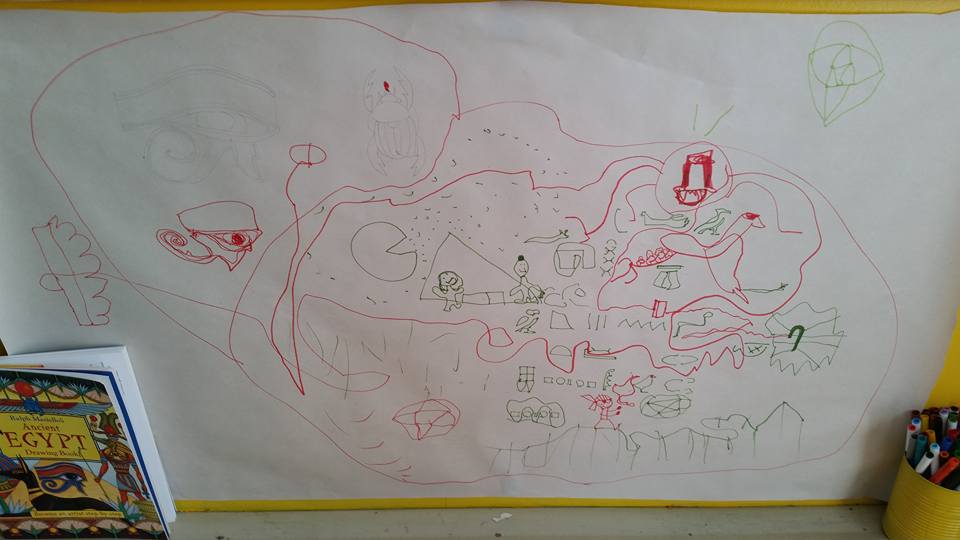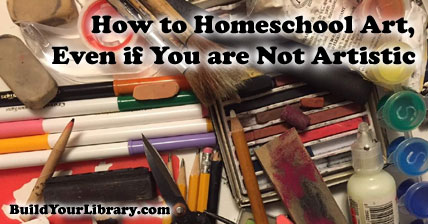How to Homeschool Art, Even if You are Not Artistic
January 30, 2017
General Tips for Incorporating More Art into your Homeschool
There are tons of resources out there about how to do simple arts and crafts projects from popsicle stick houses to egg carton caterpillars… But what do you do when the extent of your art ability is somewhere between macaroni necklace mastery and building a cotton ball snowman army, and you need to “teach” art?
Children love to cut paper into small pieces and glue anything to everything, not to mention that obscene g-word (glitter). But, no one wants to needlessly toil away at endless arts and crafts projects, just for the sake of working on “fun” hands-on activities. So how do you actually encourage and develop your child’s inner artist? It may not be as daunting of a task as you think.

First, keep your expectations in check. You may or may not be grooming the second coming of Rembrandt, probably the latter, and that’s OK. But if your child is showing an advanced interest or proficiency in art, that is a great hobby to pursue. Resist the urge to criticize or place unrealistic expectations on to their artwork. Especially when they are younger or particularly proud of a piece, but support and supplement their art education as much as you can.
Start them young and start them cheap. Early on in our homeschool journey we realized that wire bound sketchbooks can get expensive. $5 for 80-100 sheets of premium drawing paper? Sure they were convenient, but do you know what is far more cost effective? A $2.50 package of the cheap copy/printer paper. Typically you can buy it by the ream of 500 sheets at Walmart, or by the case at Amazon. Your young child can tear through this using crayons, lead pencils, color pencils or markers.
You can encourage your child to doodle until their heart is content, and don’t have to stress about mindless scribbles wasting “expensive” wire bound sketchbook pages. The down side is all of the loose drawing paper scattered all over the house, but you just need to keep up with saving the “masterpieces” that you want keep and throwing away the filler doodles.
Encourage artistic expressions on academic assignments. There are many places that simple drawing activities are presented throughout the Build Your Library homeschool curriculums and unit studies. Starting at an early age, students are tasked to color in maps, complete nature study sketches, populate field guides and design all sorts of posters and other art activities. Even in our Level 9 curriculum, students complete a drawing program going through Mark Kistler’s book, You Can Draw in 30 Days.
The more practice they get and the more fun they have, the more that this will boost their confidence and increase their aptitude in drawing and art. Even without a formal scope and sequence, you can grab some paper and pencils and head outdoors and find something interesting to draw. You can set up a still life on the kitchen table: let your child arrange some items like a stuffed animal, a piece of fruit, and some other fun items. Then draw, draw, draw!
Occasionally offer your child the option of creating an art based project. Instead of a one-paragraph summary of chapter 3, let them illustrate their favorite scene then verbally discuss what happened before, during and afterwards.


Sometimes messy, sometimes neat. Your child really needs to learn how to color in the lines. So practice coloring slowly and neatly in coloring books. Later on, coloring books are also great for practicing more advanced coloring techniques for older children such as creating a 3-dimensional depth and shading or playing with different lighting sources by adding correct shadows to existing line drawings.
If your child is drawing a mosquito in their nature journal, their slowest, neatest work should produce something that resembles a mosquito. But art also includes finger painting or other fun and messy projects. Mixing paint to learn how to blend other colors may not always be the cleanest activity, but it is quite educational. Purchase a color wheel and see how many different shades of certain colors you can make.
Abstract art is also a fun topic to explore and can easily be accomplished without a great deal of artistic skill. Look up some artwork by Picasso and see where your children’s creative juices flow. Simple pointillism projects with paint and q-tips is also a fun and creative activity. Look up some of the complex examples and attempt to create some simplified versions. This would also be a great activity to do along with your child.
Farm out some lessons to YouTube. There are thousands upon thousands of instructional videos out there, free to watch, available 24 hours a day and easily able to pause, rewind, and watch again and again. While you won’t become a second degree black belt in Tae Kwon Do watching YouTube videos, you can end up mastering some pretty sweet moves in drawing, painting, or other artistic disciplines. And this is a great resource if your child really wants to learn some advanced techniques that you as parent would never be able to teach them. Depending on their age, you may need to help them navigate YouTube to make sure they are finding appropriate art videos.
You can do a search for just about any art topic, but here are a couple of our favorites:
- https://www.youtube.com/user/MarkKistler (pencil drawing)
- https://www.youtube.com/user/DrawWithJazza (drawing and digital art)
- https://www.youtube.com/user/BobRossInc (oil painting landscapes)
Build your library with some quality art books. Along with the enormous amount of resources available on YouTube, there are many thousands of available books on how to draw simple animals, the human figure, complex dragons and monsters, outlandish fantasy landscapes… you name it. Artists always say that you can never have enough reference material, although we might question that if we were ever to count books on certain topics. As dinosaurs were quite popular in our house at one time, I think we counted 62 dinosaur books at one time before we called for a purchase freeze.

Find a particular subject matter that your child is interested in and see what kind of instructional art book is out there. Amazon is full of customer reviews to help you weed out books that may not be a good fit for your needs, but here are some of our favorite artists who have some great art books:
- Ed Emberley (beginning drawing for younger children)
- Mark Kistler (intermediate drawing for elementary aged children)
- Andrew Loomis (advanced drawing and sketching for older children)
While we do have more art related books than dinosaur books, but if you further categorize them in to specific drawing topics, painting and other genres, it doesn’t quite seem like we need an intervention. Yet.
Photography is art too. Almost everyone these days have smart phones, tablets, digital cameras, or other devices that can take pictures, kids included. What is great about digital images is that you can take as many pictures as your storage space allows, and then delete and retake pictures, unlike back in the day when you only had 24 pictures on a roll of film that you then had to take it to the store and wait for them to get developed.
 Start with the basics such as composition, camera angles, and proper lighting then add more techniques and concepts as your child’s interests blooms such as using the rule of thirds, taking panoramic shots, or using black and white photography.
Start with the basics such as composition, camera angles, and proper lighting then add more techniques and concepts as your child’s interests blooms such as using the rule of thirds, taking panoramic shots, or using black and white photography.
This may also springboard into digital image editing using applications such as Photoshop or other similar apps. Our youngest daughter has a ball snapping pictures with her Samsung tablet and just using the built in photo effects, filters, and editing features that came with the device. But if you want more guidance, then check out these options below:
- Digital Photography Complete Course by DK (general beginner photography)
- Scott Kelby (best resource for advanced photography and Photoshop skills)

Take a class, go on a field trip. One of our twins walks to the local public school a couple days a week to take high school art classes. She just finished Studio Art, will be taking Sculpture this semester, and is hoping to take Drawing, Digital Art, Digital Photography and Painting in the coming years. You can also find other community art classes at rec centers, community colleges or other locations.
Another idea would be taking a field trip to a local art museum to check out many different forms of art from oil paintings, bronze sculptures, ceramics and countless other mediums to lay the foundation for a deeper appreciation of the arts. Discuss the artwork you saw, talk about which pieces you liked best, research further when you get home. Look up local schedules to catch certain exhibits and see if they have a free admission days. One of the art museums near us has free admission on the second Saturday of each month from 10 a.m. until noon, then you can stay all day for free.
One of our personal favorites are attending Comic Conventions. Besides all of the other cool comic book and anime related exhibits, they usually have a huge section of professional and amateur comic book and fantasy artist booths. You can see some fantastic artwork, talk to the artists, and get some cool swag all while walking around dressed up as Pikachu or a ninja turtle!
Lastly, constructive criticism. This one goes back to our first tip and keeping expectations in check. If your child is just doing extra artwork for fun, this is less important. But if your child is doing some really exceptional work, but looks like there are some shortcomings, they should be addressed. One of the basic tenets of constructive criticism is providing a “right” if you point out a wrong. Even without a trained eye, you should be able to look at a piece of art and see if something is wrong, even if your child can’t.
Some of the more common issues could be inaccurate perspective, awkward figure poses or some other anatomically incorrect rendering. This could possibly produce one of two mindsets in your child. One, “it’s fine” or two, “I just can’t draw hands or feet!” — both of which are not true. If there is a specific problem, there is a video or book describing specifically how to correct this particular shortcoming if you care to find it.
There are tons of general drawing books that quickly go over a broad range of topics, but there are also books such as Perspective Made Easy: A Step-by-Step Guide by Robbie Lee, Figure It Out! Drawing Essential Poses by Christopher Hart or any of a number of other books or videos can be found on very specific topics from just drawing hands, feet, faces, and clothes on people. Titles like these will give you everything you ever wanted to learn about that particular topic, but were afraid to ask.
 The earlier you address this the better, before your child trains himself to draw something consistently incorrect. Then, instead of teaching a topic, you have to break a bad habit first. For far too long, one of our kids would draw some really good comic book style characters — except they were all just standing there doing nothing. So we got some more books on drawing dynamic figure poses. Once she broke this habit of drawing statuesque figures, we noticed she needed some work on limbs. Apparently she knew that already, but decided that it was easier to just draw all the characters standing still, instead of having them performing actions. Basically she said both “it’s fine” and “I just can’t draw hands or feet!” But after a few Jazza videos, she is correcting some of the issues she was having with foreshortening and hand and foot posturing.
The earlier you address this the better, before your child trains himself to draw something consistently incorrect. Then, instead of teaching a topic, you have to break a bad habit first. For far too long, one of our kids would draw some really good comic book style characters — except they were all just standing there doing nothing. So we got some more books on drawing dynamic figure poses. Once she broke this habit of drawing statuesque figures, we noticed she needed some work on limbs. Apparently she knew that already, but decided that it was easier to just draw all the characters standing still, instead of having them performing actions. Basically she said both “it’s fine” and “I just can’t draw hands or feet!” But after a few Jazza videos, she is correcting some of the issues she was having with foreshortening and hand and foot posturing.
As with any endeavor, “you only get out what you put in to it.” If your newly acquired art books just sit on a shelf and collect dust, or if instructional videos are watched once and then never practiced or tried, there will be minimal improvement.
Personally, we ended up with 2 very artistic children with above average art skills interested in pursuing advanced art studies. We also have 2 comfortable artists who can get by drawing simple pictures when necessary. Besides, it is really helpful when playing Win, Lose or Draw or Pictionary during family game night if everyone in the house can draw reasonably well. 🙂
But moreso, we have raised our children to see the beauty in the world. Because we’ve put importance on art, they have honed their observational skills, learned that different people can perceive things differently from themselves, and they know that even mistakes can become something beautiful. Art teaches our children to really see things, and gives them a new and different way to express themselves.
Related Article(s): Can You Teach Creativity?
 Emily Cook is the author and creator of the secular homeschool curriculum Build Your Library, a literature-based K-12 program infused with the teachings of Charlotte Mason. She writes full year lesson plans as well as shorter topical unit studies. Emily has been homeschooling her four children in Southern NH for 21 years. She is passionate about reading aloud to children of all ages and loves to share her love of literature with others. She and her family also makes incredibly dorky videos about homeschooling, books and more on Youtube at ARRRGH! Schooling. You can follow her on Facebook, Twitter and Pinterest.
Emily Cook is the author and creator of the secular homeschool curriculum Build Your Library, a literature-based K-12 program infused with the teachings of Charlotte Mason. She writes full year lesson plans as well as shorter topical unit studies. Emily has been homeschooling her four children in Southern NH for 21 years. She is passionate about reading aloud to children of all ages and loves to share her love of literature with others. She and her family also makes incredibly dorky videos about homeschooling, books and more on Youtube at ARRRGH! Schooling. You can follow her on Facebook, Twitter and Pinterest.
Post Comments from ![]() Facebook
Facebook
Melody via Facebook (1/30/2017) – I am an artist who started art school at age 10. I have a degree in art. I feel very strongly about art education. Hearing someone say they don’t have an artistic bone in their body is like nails on a chalk board for me. I feel very strongly that anyone, even someone who has never picked up a paint brush as and adult, has just as much need to express themselves artistically as a classically trained artist. It’s not about recognition or feeling skilled (those are nice too) but the real point is process and brain power. Art is mostly about practice not flashes of inspiration. Your post really helps stamp out some basic principles & I think your curriculum supports it beautifully. Thank you for encouraging this essential part of education!
